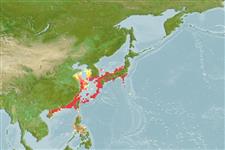Environment: milieu / climate zone / depth range / distribution range
Ecologie
marien rifbewoner; diepte 10 - 50 m (Ref. 5222). Tropical; 39°N - 12°N, 110°E - 143°E (Ref. 5222)
Northwest Pacific: Korea, Japan, Taiwan, China, Viet Nam, and islands in the South China Sea.
Lengte bij maturiteit / Grootte / Gewicht / Leeftijd
Maturity: Lm ?, range 16 - ? cm
Max length : 60.0 cm TL mannelijk / geslacht onbekend; (Ref. 5222); common length : 30.0 cm TL mannelijk / geslacht onbekend; (Ref. 9137)
Dorsale stekels (totaal): 11; Dorsale zachte stralen (totaal): 15-16; Anale stekels 3; Anale zachte stralen: 8. Distinguished by the following characteristics: head and body pale greyish brown dorsally, usually golden yellow ventrally; 4 broad dark bars on the dorsal part of the body, one on caudal peduncle and another often visible on nape; numerous small yellow spots on head and body; body and median fins with small greyish white spots; soft dorsal and caudal fins and sometimes the anal fin, with prominent yellow margin; dusky yellow paired fins; yellow mustache in the maxillary groove; body depth 2.7-3.3 times in SL; head length 2.3-2.6 times in SL; convex interorbital area; strongly convex dorsal head profile; subangular preopercle, 2-5 strong spines at the angle; upper edge of operculum straight, uppermost spine rudimentary; maxilla reaches about to vertical at rear edge of eye; 2 rows of small, subequal teeth on midlateral part of lower jaw; caudal fin convex; lateral body scales distinctly ctenoid, with auxiliary scales in fish larger than 30 cm SL; pyloric caeca 12, in 3 bundles (Ref. 089707).
Occurs in rocky areas as well as on sandy-mud bottoms. Juveniles are common in tide pools. In captivity, the species is aggressive, chasing and biting other species, especially members of its own species. Protogynous hermaphrodite (Ref. 5222). Artificial fertilization of eggs was done and the longest survival time for the larvae was 15 days (Ref. 6780). In Hong Kong live fish markets (Ref. 27253).
Heemstra, P.C. and J.E. Randall, 1993. FAO Species Catalogue. Vol. 16. Groupers of the world (family Serranidae, subfamily Epinephelinae). An annotated and illustrated catalogue of the grouper, rockcod, hind, coral grouper and lyretail species known to date. Rome: FAO. FAO Fish. Synop. 125(16):382 p. (Ref. 5222)
Status op de Rode Lijst van het IUCN (Ref. 130435)
Gevaar voor de mens
Harmless
Gebruik door de mens
Visserij: commercieel; Aquacultuur: commercieel
Tools
Speciale rapporten
Download XML
Internetbronnen
Estimates based on models
Preferred temperature (Ref.
123201): 16.2 - 25.6, mean 22.5 °C (based on 74 cells).
Fylogenetische diversiteitsindex (Ref.
82804): PD
50 = 0.5000 [Uniqueness, from 0.5 = low to 2.0 = high].
Bayesian length-weight: a=0.01122 (0.00656 - 0.01920), b=3.04 (2.90 - 3.18), in cm total length, based on LWR estimates for this species & Genus-body shape (Ref.
93245).
Trofisch niveau (Ref.
69278): 3.6 ±0.55 se; based on food items.
Weerstandsvermogen (Ref.
120179): Hoog, minimale populatieverdubbelingstijd minder dan 15 maanden (Fecundity = 24,329).
Fishing Vulnerability (Ref.
59153): Moderate vulnerability (44 of 100).
Nutrients (Ref.
124155): Calcium = 25.4 [12.5, 56.5] mg/100g; Iron = 0.474 [0.258, 0.967] mg/100g; Protein = 18.4 [16.9, 19.8] %; Omega3 = 0.113 [0.070, 0.180] g/100g; Selenium = 34.9 [21.0, 62.3] μg/100g; VitaminA = 167 [47, 594] μg/100g; Zinc = 1.34 [0.94, 1.87] mg/100g (wet weight);
